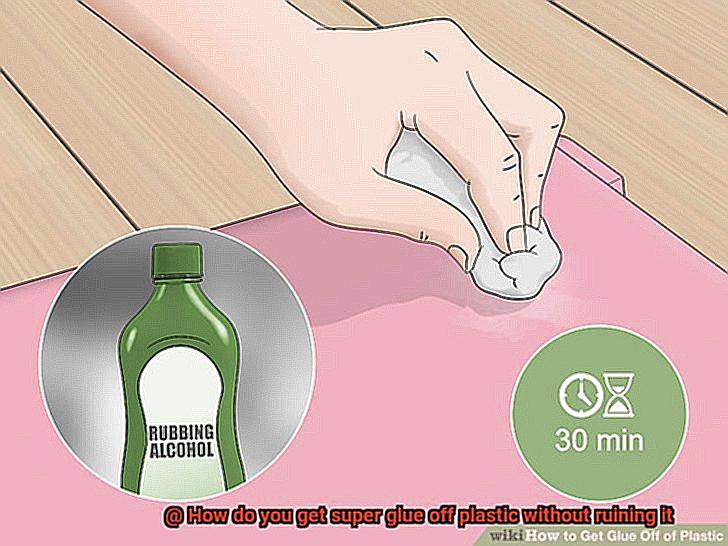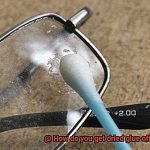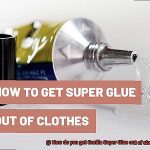Do you find yourself in a sticky situation, battling with the clingy clutches of super glue on your plastic treasures?
We’ve all been there, desperately seeking a way to bid farewell to that pesky adhesive without causing any harm. Well, worry not.
This blog post is about to spill some secrets on how to liberate your plastic possessions from the grips of super glue, without leaving a trace. Whether it’s a beloved action figure or a pricey gadget, we’ve got your back.
So, put on your superhero cape and let’s embark on this adventure of glue removal where chaos transforms into tranquility.
What is Super Glue and How Does it Damage Plastic?
Contents
- 1 What is Super Glue and How Does it Damage Plastic?
- 2 Acting Quickly to Remove Super Glue from Plastic
- 3 Using Acetone as a Remedy for Super Glue on Plastic
- 4 Alternative Methods for Removing Super Glue from Plastic
- 5 Using Rubbing Alcohol or Isopropyl Alcohol to Dissolve Super Glue
- 6 Utilizing Heat to Soften and Remove Super Glue from Plastic
- 7 Exercise Caution When Removing Super Glue from Plastic
- 8 Testing Solvents and Cleaning Agents Before Use
- 9 Conclusion

Super glue, also known as cyanoacrylate adhesive, is a powerful bonding agent that can be used for a variety of purposes. It is renowned for its quick-drying properties and exceptional strength.
However, when it comes to plastic surfaces, super glue can cause damage if not used correctly. In this blog post, we will delve into what super glue is, how it can damage plastic, and provide tips for safe removal.
Super glue is a fast-bonding adhesive that forms a strong and durable bond within seconds. By reacting with moisture in the air, it polymerizes and hardens rapidly, allowing for almost instantaneous bonding between surfaces.
Commonly used for bonding plastics, among other materials, super glue provides a reliable solution for various applications.
How Does Super Glue Damage Plastic?
- Blooming: Super glue can create a white haze or fog on plastic surfaces, known as blooming. This occurs when the glue evaporates and leaves behind a stubborn residue that is challenging to remove without causing further damage.
- Discoloration: Transparent or light-colored plastics are particularly susceptible to turning yellow or becoming cloudy when exposed to super glue over time. This discoloration can detract from the appearance of the plastic surface.
- Chemical Reaction: Some plastics contain chemicals that react with the cyanoacrylate in super glue, resulting in a weakened bond or even the disintegration of the plastic surface itself. Understanding the compatibility between the specific plastic and super glue is crucial in avoiding such damage.
- Brittle Bonds: Excessive amounts of super glue on plastic surfaces can lead to brittle and fragile bonds. The excessive glue prevents proper contact between the surfaces being bonded, resulting in weak bonds that easily break under stress.
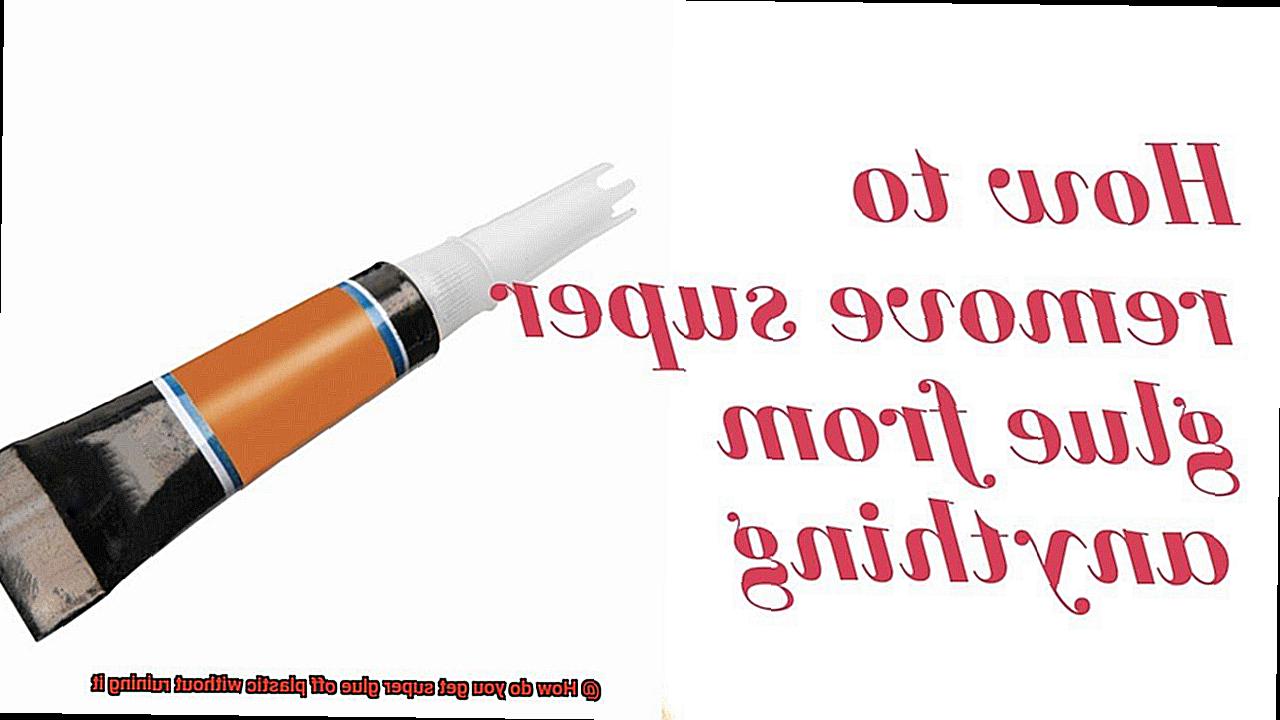
Tips for Safe Removal:

- Act quickly: Address the issue as soon as possible to prevent the glue from setting and becoming harder to remove.
- Choose the right method: Consider the type of plastic and the amount of glue present before selecting a removal method.
- Acetone: For many plastics, acetone can be an effective solvent to dissolve super glue. Test it on a small, inconspicuous area first to ensure it doesn’t cause damage or discoloration.
- Warm Soapy Water: Soaking the affected area in warm soapy water can help soften the glue and make it easier to remove. Gently scrub with a soft cloth or sponge.
- Rubbing Alcohol: Using rubbing alcohol or isopropyl alcohol can also dissolve super glue. Apply a small amount and gently rub the area, then scrape off the softened glue.
- Heat: For rigid plastics like PVC or ABS, applying gentle heat with a hairdryer or heat gun can soften the glue, making it easier to peel off.

Acting Quickly to Remove Super Glue from Plastic
Accidentally spilling super glue on your favorite plastic item can send anyone into a panic. But fear not. Acting quickly is the key to removing super glue from plastic without causing any damage. In this guide, I will walk you through effective methods that will help you tackle this sticky situation like a pro.
- Protect and Dab: Before you dive into the removal process, take a moment to protect your hands by wearing gloves. Then, grab a clean cloth or paper towel and gently dab at the affected area. This simple step will prevent the glue from spreading and causing further damage.
- Acetone Magic: Acetone is a powerful solvent that can effectively break down super glue. However, it’s crucial to test it on a small, inconspicuous area of the plastic first to ensure it won’t cause any damage or discoloration. Once you’ve confirmed its safety, apply a small amount of acetone to a cotton ball or swab and gently rub it on the glue. Be patient, as it may take some time and repeated applications for the glue to dissolve completely.
- Alcohol Alternative: If you don’t have acetone on hand or prefer a milder option, isopropyl alcohol can also do the trick. Again, test it on a small area first to avoid any potential damage. Once confirmed safe, apply the alcohol to a cotton ball or swab and gently rub it on the glue. The alcohol will work its magic by breaking down the adhesive properties of the super glue, making it easier to remove.
- Heat It Up: Delicate plastics like acrylic or polycarbonate require extra care. For these materials, heat can be your best friend. Grab a trusty hairdryer or heat gun and warm up the glue. As the glue softens under the heat, you can easily peel it off using a plastic scraper or even your fingers. Just remember not to overheat the plastic to avoid any unwanted consequences.
- Commercial Solutions: If all else fails, fear not. There are commercial adhesive removers available specifically designed for removing super glue from plastic. These products can be found in hardware stores or online, and they come with detailed instructions on how to use them effectively. Just make sure to follow the manufacturer’s guidelines for best results.
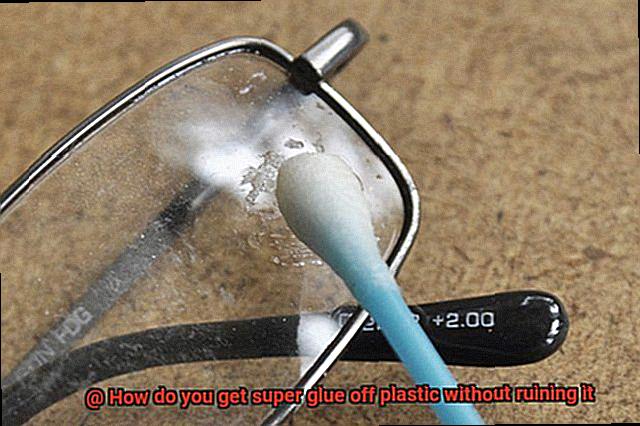
Using Acetone as a Remedy for Super Glue on Plastic
We have the secret to safely and effectively removing super glue from plastic using the magical powers of acetone.
But before we dive into the removal process, let’s talk about the different types of plastics. Not all plastics are created equal, my friend. Some, like PVC and polystyrene, are not acetone-resistant and can be easily damaged by this powerful solvent. So, before you go all in, perform a spot test in an inconspicuous area to make sure your plastic can handle the acetone treatment.
Assuming your plastic is acetone-resistant (fingers crossed.), let’s gather the necessary materials for this super glue disappearing act. You’ll need acetone, which you can easily find in most hardware or home improvement stores. And don’t forget some cotton balls or swabs for application.
Now that we have our supplies ready, it’s time to work our magic. Take a small amount of acetone and pour it onto a cotton ball or swab. Be careful not to saturate the cotton too much, as excessive amounts of acetone can seep into crevices and cause damage. We don’t want that.
With your saturated cotton ball or swab in hand, gently dab it onto the super glue on the plastic surface. Apply even pressure and avoid any vigorous rubbing that could potentially scratch the plastic. Let the acetone sit on the super glue for a few minutes to allow it to work its magic and dissolve that stubborn adhesive.
After a few minutes of anticipation, it’s time to start peeling off the softened super glue using your trusty fingernail or a soft cloth. If needed, reapply more acetone and repeat the process until every last trace of super glue is gone. Victory is within reach.
But wait, we’re not done yet. Now it’s time to give your plastic surface a thorough cleaning. Both the acetone and super glue residue can leave behind a greasy film, so grab some mild soap or detergent mixed with water. Gently scrub the surface with a soft cloth or sponge to remove any remaining residue, and then rinse with clean water.
Before you break out the confetti, make sure to pat dry the plastic surface with a clean towel or allow it to air dry completely. We don’t want any moisture lingering around, as that could potentially cause further damage or degradation of the plastic.
Oh, and a word of caution: always use acetone in a well-ventilated area to avoid any unpleasant fumes. And protect your precious skin and eyes by wearing gloves and protective eyewear when handling acetone. Safety first.
Alternative Methods for Removing Super Glue from Plastic
We’ve all experienced that sinking feeling when a drop of super glue ends up on our favorite plastic item. But don’t despair. In this blog post, we’ll delve into alternative methods for removing super glue from plastic. With these tricks up your sleeve, you’ll be able to restore your plastic treasures to their former glory.
Acetone:
Our first hero in the battle against super glue is acetone. This powerful solvent can break down the bond of the glue without damaging the plastic. Apply a small amount of acetone to the affected area, let it sit for a few minutes, then gently rub with a cotton swab or cloth. Repeat if needed until the glue disappears.
Nail Polish Remover:
If acetone isn’t available, nail polish remover containing acetone can be an effective alternative. Apply it to a cotton swab or cloth and gently rub onto the glue until it dissolves. Wipe away any residue with a clean cloth.
Warm Soapy Water:
For delicate plastics or gentler methods, try warm soapy water. Fill a bowl with warm water and dish soap, then let the item soak for 15-20 minutes. Gently rub away the softened glue using a soft cloth or sponge. Rinse and dry thoroughly.
Rubbing Alcohol:
Another option is rubbing alcohol. Moisten a cotton swab or cloth with alcohol and gently rub onto the glue until it dissolves. Wipe away any residue with a clean cloth.
Olive Oil or Cooking Oil:
In some cases, olive oil or cooking oil can work wonders in removing super glue from plastic surfaces. Apply a small amount of oil and let it sit for a few minutes. Gently rub with a soft cloth or sponge until the glue loosens. Wipe away the glue and clean the surface with mild soap and water.
Using Rubbing Alcohol or Isopropyl Alcohol to Dissolve Super Glue
We’ve all experienced the frustration of a super glue mishap that leaves our plastic treasures stuck together. But fear not. In this guide, we’ll delve into the world of rubbing alcohol and its ability to dissolve super glue from plastic surfaces. Say goodbye to sticky situations and hello to restored plastic wonders.
Step-by-Step Instructions:
- Gather your supplies: You’ll need rubbing alcohol (also known as isopropyl alcohol), a clean cloth or cotton ball, and a gentle touch.
- Apply the alcohol: Take a small amount of rubbing alcohol and apply it to a clean cloth or cotton ball. Ensure that the entire glue spot is covered.
- Let it sit: Allow the rubbing alcohol to sit on the glue for a few minutes. This allows it to penetrate and loosen the adhesive, making it easier to remove.
- Gently rub: After a few minutes, gently rub the glue spot with the cloth or cotton ball. Use light pressure and circular motions to loosen the glue from the plastic surface. Avoid excessive scrubbing to prevent damage.
- Keep going: Continue rubbing until you witness the super glue start to dissolve and come off. For stubborn or larger glue spots, apply more rubbing alcohol if necessary.
- Wipe away residue: Once the super glue is completely dissolved and removed, use a clean cloth or paper towel to wipe away any residue or excess rubbing alcohol from the plastic.
Potential Risks:
While rubbing alcohol is generally safe for most plastics, it’s crucial to test a small, inconspicuous area before applying it to the entire surface. Some plastics may discolor or become damaged when exposed to rubbing alcohol. If you notice any adverse effects or discoloration, cease using rubbing alcohol immediately and try an alternative method.
Utilizing Heat to Soften and Remove Super Glue from Plastic
We’ve got a solution that’ll have your plastic wonders looking as good as new. In this guide, we’ll explore the power of heat and how it can safely soften and remove super glue from plastic without causing any damage.
One popular method is using a hairdryer on a low setting. By gently heating the glue, it becomes softer and easier to remove. Start by keeping the hairdryer at a safe distance from the plastic to prevent any melting or warping. Then, direct the warm air onto the glued area, moving the hairdryer in a back-and-forth motion. As the glue softens, grab a plastic scraper or even a credit card to carefully scrape off the softened glue. Remember to be gentle to avoid scratching the plastic surface.
Another heat-based option is using hot water. Fill a basin or sink with hot water, not boiling, and immerse the plastic item with the super glue in it. Allow it to soak for a few minutes, giving the heat time to work its magic on the glue. After soaking, use a soft cloth or sponge to gently scrub away the softened glue. For smaller objects like toys or electronic devices, you can also try placing them in a sealed plastic bag and submerging them in hot water for more concentrated heat application.
However, it’s crucial to note that excessive heat can potentially damage certain types of plastics. To avoid any mishaps, start with lower temperatures and test in an inconspicuous area first. Additionally, always exercise caution when using heat near flammable materials or surfaces.
Once you’ve successfully removed the super glue, take a moment to give your plastic surface some TLC. Clean it with mild soap and water to remove any residue that may be left behind.
If these heat-based methods don’t do the trick or you’re concerned about potential damage, it may be best to seek professional assistance or use specialized adhesive removers specifically designed for removing super glue from plastic surfaces.
Exercise Caution When Removing Super Glue from Plastic
When it comes to removing super glue from plastic, caution is key. Super glue is known for its strong bonding properties, and attempting to remove it without proper care can result in damage to the plastic surface. To safely and effectively remove super glue from plastic, follow these guidelines:
- Test the solvent: Before applying any solvent to the plastic, it is crucial to test it on a small, inconspicuous area first. This will help determine if the solvent will cause any discoloration, melting, or other damage to the plastic. Acetone is a common solvent used for removing super glue, but it can be harmful to certain types of plastic. Rubbing alcohol (isopropyl alcohol) is generally safer to use on most plastics.
- Acetone method: If acetone is safe to use on your plastic, soak a cotton ball or a clean cloth in acetone and gently dab it onto the glued area. Allow the acetone to sit for a few minutes to soften the glue. Then, using a plastic scraper or your fingernail, carefully scrape off the softened glue. Apply gentle pressure and avoid using sharp objects that could scratch or gouge the plastic.
- Rubbing alcohol method: If acetone is not an option or if you prefer a milder solvent, rubbing alcohol can also be effective in removing super glue from plastic. Pour some rubbing alcohol onto a cotton ball or a clean cloth and apply it to the glued area. Let the alcohol sit for a few minutes, and then gently rub the glue with the cloth or use your fingernail to scrape it off. Again, be gentle and avoid causing any damage to the plastic surface.
- Warm soapy water method: In some cases, warm soapy water can be used to remove super glue from plastic. Soak the glued area in warm soapy water for several minutes to soften the glue. Then, use a soft cloth or sponge to gently scrub away the glue. Rinse with clean water and dry the plastic thoroughly.
- Follow manufacturer’s instructions: It is important to note that not all plastics are the same, and some may be more sensitive to certain solvents. Always read and follow the instructions provided by the manufacturer of the plastic item to avoid causing any damage.
- Seek professional help if needed: If you are facing a particularly stubborn super glue situation or if you are unsure about using solvents on your plastic, it may be best to seek professional help. A professional can assess the situation and determine the safest and most effective method for removing the super glue without damaging the plastic.
Testing Solvents and Cleaning Agents Before Use
Imagine accidentally spilling super glue on your favorite plastic item and feeling a wave of panic wash over you.
With the right approach, you can safely remove the stubborn adhesive without causing any damage.
The key lies in testing solvents and cleaning agents before use. In this article, we will explore the critical importance of testing, provide a step-by-step process, and offer valuable tips to ensure successful removal of super glue while preserving the integrity of your plastic surface.
Why Testing is Critical:
Different plastics react differently to various chemicals, making it essential to test solvents and cleaning agents before diving in. This precaution allows you to identify any potential adverse effects on the plastic, such as discoloration, melting, or warping. By taking this small step, you can avoid frustration and prevent potential damage in the long run.
Step-by-Step Testing Process:
- Choose an inconspicuous area on the plastic to perform the test.
- Apply a small amount of the solvent or cleaning agent onto a cotton swab or soft cloth.
- Gently rub the solvent onto the test area using circular motions.
- Observe any changes in the plastic surface for a few minutes.
If no noticeable damages occur, it is likely safe to proceed with that particular solvent or cleaning agent.
What if Damage Occurs?
If you notice any adverse effects during the test, immediately stop using that specific solvent or cleaning agent. It is crucial to explore alternative options until you find one that is safe for your specific type of plastic.
Extra Precautions:
Even if a solvent or cleaning agent passes the initial test, exercise caution when applying it to larger areas. Begin by applying a small amount to an inconspicuous part of the glue residue and monitor its effect over a short period. This additional step ensures that there are no unexpected reactions when dealing with a larger surface area.
Consider the Application Method:
The method of application can also influence the success of removing super glue without damaging the plastic. Some solvents may work best when applied directly to the glue, while others may be more effective when applied to a cloth or sponge and then used to gently rub the glue off the plastic surface.
_59ZzuLJcTw” >
Also Read: How To Remove Glue On Plastic Container?
Conclusion
Don’t let stubborn super glue ruin your precious plastic possessions. There are numerous effective methods you can employ to liberate them from this adhesive menace without causing any harm.
One option is acetone – that mighty solvent that’s got what it takes to break down even the toughest super glue bonds. Just grab a cloth or cotton swab, add a touch of acetone, and gently massage the affected area until that pesky glue starts surrendering its grip.
Rubbing alcohol is another trusty ally in this battle against stickiness – its powers can help loosen the hold of super glue on plastic surfaces.
Simply dampen a cloth with rubbing alcohol and carefully dab away at the glue until it begins to soften and give in. When dealing with more delicate plastics like acrylic or polycarbonate, you’ll want to proceed with caution. Opt for gentler solutions like vinegar or lemon juice – their acidic nature can work wonders in dissolving super glue.
Apply these zesty liquids onto a cloth, lovingly caress the glue away, and don’t forget to rinse the plastic thoroughly afterward to remove any lingering traces.

